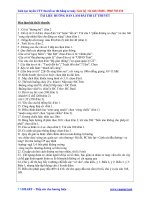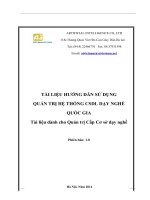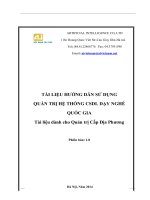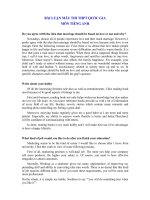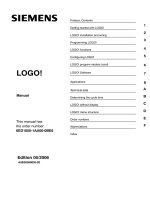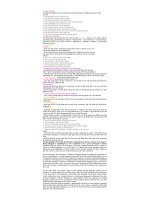- Trang chủ >>
- THPT Quốc Gia >>
- Ngoại Ngữ
Tài liệu hướng dẫn làm bài tự luận Tiếng Anh kỳ thi THPT Quốc gia 2015 cực hay
Bạn đang xem bản rút gọn của tài liệu. Xem và tải ngay bản đầy đủ của tài liệu tại đây (3.39 MB, 79 trang )
HOW TO WRITE A PARAGRAPH
Parts of a Paragraph
1. Topic Sentence
2. Supporting Details
3. Closing Sentence
How to Write a
Paragraph
1. Prewriting Paragraphs
2. Writing Paragraphs
3. Editing Paragraphs
4. Publishing Paragraphs
Kinds of Paragraphs
1. Definition 5. Sequence
2. Classification 6. Choice
3. Description 7. Explanation
4. Compare and Contrast 8. Evaluation
PART 1: Parts of a Paragraph
1. Topic Sentence
What is the topic sentence?
The topic sentence is the first sentence in a paragraph.
What does it do?
It introduces the main idea of the paragraph.
How do I write one?
Summarize the main idea of your paragraph. Indicate to the reader what
your paragraph will be about.
Example:
There are three reasons why Canada is one of the best countries in
the world. First, Canada has an excellent health care system. All
Canadians have access to medical services at a reasonable price.
Second, Canada has a high standard of education. Students are taught by
well-trained teachers and are encouraged to continue studying at
university. Finally, Canada's cities are clean and efficiently managed.
Canadian cities have many parks and lots of space for people to live. As
a result, Canada is a desirable place to live.
2. Supporting Details
What are supporting sentences?
They come after the topic sentence, making up the body of a paragraph.
What do they do?
They give details to develop and support the main idea of the paragraph.
How do I write them?
You should give supporting facts, details, and examples.
Example:
There are three reasons why Canada is one of the best countries in the
world. First, Canada has an excellent health care system. All
Canadians have access to medical services at a reasonable price.
Second, Canada has a high standard of education. Students are
taught by well-trained teachers and are encouraged to continue
studying at university. Finally, Canada's cities are clean and
efficiently managed. Canadian cities have many parks and lots of
space for people to live. As a result, Canada is a desirable place to live.
3. Closing Sentence
What is the closing sentence?
The closing sentence is the last sentence in a paragraph.
What does it do?
It restates the main idea of your paragraph.
How do I write one?
Restate the main idea of the paragraph using different words.
Example:
There are three reasons why Canada is one of the best countries in the
world. First, Canada has an excellent health care system. All Canadians
have access to medical services at a reasonable price. Second, Canada
has a high standard of education. Students are taught by well-trained
teachers and are encouraged to continue studying at university. Finally,
Canada's cities are clean and efficiently managed. Canadian cities have
many parks and lots of space for people to live. As a result, Canada is
a desirable place to live .
PART 2: How to Write a Paragraph
1. Prewriting Paragraphs
What is the prewriting stage?
The prewriting stage is when you think carefully and organize your
ideas for your paragraph before you begin writing.
Six Prewriting Steps:
1. Think carefully about what you are going to write. Ask yourself:
o What question am I going to answer in this paragraph or essay?
o How can I best answer this question? What is the most important
part of my answer?
o How can I make an introductory sentence (or thesis statement)
from the most important part of my answer?
o What facts or ideas can I use to support my introductory
sentence?
o How can I make this paragraph or essay interesting?
o Do I need more facts on this topic?
o Where can I find more facts on this topic?
2. Open your notebook. Write out your answers to the above questions.
You do not need to spend a lot of time doing this; just write enough to
help you remember why and how you are going to write your paragraph
or essay.
3. Collect facts related to your paragraph or essay topic. Look for
and write down facts that will help you to answer your question.
Timesaving hint: make sure the facts you are writing are related to the
exact question you are going to answer in your paragraph or essay.
4. Write down your own ideas. Ask yourself:
o What else do I want to say about this topic?
o Why should people be interested in this topic?
o Why is this topic important?
5. Find the main idea of your paragraph or essay. Choose the most
important point you are going to present. If you cannot decide which
point is the most important, just choose one point and stick to it
throughout your paragraph or essay.
6. Organize your facts and ideas in a way that develops your main
idea. Once you have chosen the most important point of your paragraph
or essay, you must find the best way to tell your reader about it. Look at
the facts you have written. Look at your own ideas on the topic. Decide
which facts and ideas will best support the main idea of your paragraph.
Once you have chosen the facts and ideas you plan to use, ask yourself
which order to put them in the paragraph. Write down your own note set
that you can use to guide yourself as you write your paragraph or essay.
2. Writing Paragraphs
What is the writing stage?
The writing stage is when you turn your ideas into sentences.
Five Writing Steps:
1. Open your notebook and word processor.
2. Write the topic sentence, supporting sentences, and closing sentence.
3. Write clear and simple sentences to express your meaning.
4. Focus on the main idea of your paragraph.
5. Use the dictionary to help you find additional words to express your
ideas.
3. Editing Paragraphs
What is the editing stage?
The editing stage is when you check your paragraph for mistakes and
correct them.
Grammar and Spelling
1. Check your spelling.
2. Check your grammar.
3. Read your essay again.
4. Make sure each sentence has a subject.
5. See if your subjects and verbs agree with each other.
6. Check the verb tenses of each sentence.
7. Make sure that each sentence makes sense.
Style and Organization
1. Make sure your paragraph has a topic sentence.
2. Make sure your supporting sentences focus on the main idea.
3. Make sure you have a closing sentence.
4. Check that all your sentences focus on the main idea.
5. See if your paragraph is interesting.
4. Publishing Paragraphs
What is the publishing stage?
The publishing stage is when you produce a final copy of your
paragraph to hand in.
Three Publishing Steps:
1. Make a paper copy of your paragraph.
2. Show your work to your teacher, tutor, or parents.
3. Ask them for hints on how to improve your writing.
PART 3: Kinds of Paragraphs
1. Definition Paragraph
When writing a definition paragraph, you take a thing or an idea and
explain what it is.
Example: Write a paragraph giving the definition of a pest.
The following words can help you to write a good definition
paragraph:
1. "is defined as"
Example: A pest is defined as any animal or plant that damages crops,
forests, or property.
2. "is a kind of"
Example: A pest is a kind of animal or plant that damages crops,
forests, or property.
2. Classification Paragraph
When writing a classification paragraph, you group things or ideas into
specific categories.
Example: Write a paragraph discussing two types of energy
resources.
The following words can help you to write a good classification
paragraph:
o is a kind of Coal is a kind of non-renewable resource.
o can be divided into Energy resources can be divided into two
types.
o is a type of Coal is a type of non-renewable resource.
o falls under Coal falls under the category of non-renewable
resources.
o belongs to Coal belongs to the category of non-renewable
resources.
o is a part of Coal is a part of the category of non-renewable
resources.
o fits into Coal fits into the category of non-renewable resources.
o is grouped with Coal is grouped with non-renewable
resources.
o is related to Coal is related to other non-renewable resources.
o is associated with Coal is associated with other non-renewable
resources.
3. Description Paragraph
In a description paragraph, you are writing about what a person, place,
or thing is like. Sometimes, you may describe where a place is located.
Examples
Write a paragraph describing what a polar bear looks
like.
Describe where Canada's industry is located.
The following words can help you to write a good description
paragraph:
Properties Measurement Analogy Location
size length is like in
colour width resembles above
shape mass/weight below
purpose speed beside
near
north/east/south/west
Properties
Size
Example: Polar bears are big in size.
Colour
Example: Polar bears are usually white in colour.
Shape
Example: Polar bears have a special shape.
Purpose
Example: The purpose of the polar bear's fur is to keep it warm.
Measurement
Length
Example: The length of a polar bear's claws is 20 cm.
Width
Example: The width of a polar bear's head is about 50 cm.
mass / weight
Example: Polar bears weigh up to 650 kg.
Speed
Example: Polar bears can swim at a speed of 40 km per hour.
Analogy
Is like
Example: A polar bear is like other bears in shape.
Resembles
Example: A polar bear resembles other bears in shape.
Location
In
Example: Most of Canada's manufacturing is located in Ontario and
Quebec.
Above
Example: The ceiling is above us.
Below
Example: Most of Ontario is below Hudson Bay.
Beside
Example: Quebec is located beside Ontario.
Near
Example: Many companies are located near Toronto.
north / east / south / west
Example: Ontario is west of Quebec.
4. Compare and Contrast Paragraph
In a compare and contrast paragraph, you write about the similarities
and differences between two or more people, places, things, or ideas.
Example: Write a paragraph comparing the weather in Vancouver and
Halifax.
The following words can help you to write a good compare and
contrast paragraph:
Similarities Differences
is similar to the other hand
both however
also but
too in contrast
as well differs from
while
unlike
Similarities
is similar to
Example: Spring weather in Vancouver is similar to spring weather in
Halifax.
Both
Example: Both Vancouver and Halifax have rain in the spring.
Also
Example: Halifax also has a rainy spring season.
Too
Example: Halifax has a rainy spring season, too.
As well
Example: As well, Halifax has rainy spring season.
Differences
On the other hand
Example: On the other hand, winter is much colder in Halifax.
However
Example: However, winter is much colder in Halifax.
But
Example: Vancouver has a mild winter, but Halifax has a cold one.
In contrast to
Example: In contrast to Vancouver, Halifax has a cold winter.
Differs from
Example: Halifax differs from Vancouver by having a cold winter.
While
Example: While Vancouver has a mild winter, Halifax has a cold
winter.
5. Sequence Paragraph
In a sequencing paragraph, you are writing to describe a series of events
or a process in some sort of order. Usually, this order is based on time.
Example: Write a paragraph outlining how a person becomes the prime
minister.
The following words can help you to write a good sequence paragraph.
Order Time
first, second, third, etc. recently
in the beginning previously
before afterwards
then when
after after
finally
at last
subsequently
Order
First, second, third, etc.
Example: First, you need to become a leader of a political
party. Second, you need to win a seat in the House of Commons. Third,
your party must have a majority of seats.
In the beginning
Example: In the beginning, you need to become a leader of a political
party.
Before
Example: Before becoming the prime minister, you need to become
the leader of a political party.
Then
Example: Then, you must win a seat in the House of Commons.
After
Example: After winning a seat in the House of Commons, you must
make sure you have a majority of seats.
Finally
Example: Finally, after all these steps, you can call yourself the prime
minister.
at last
Example: At last, you can call yourself the prime minister.
Subsequently
Example: Subsequently, you must make sure you have a majority of
seats in the House of Commons.
Time
Recently
Example: She was recently elected prime minister.
Previously
Example: She is the new prime minister. Previously, she worked as a
lawyer in Toronto.
Afterwards
Example: She won the party leadership last year. Afterwards, she won
the election.
When
Example: When she won the party leadership, she was still working as
a lawyer.
after
Example: After winning a seat in the House of Commons, you must
make sure you have a majority of seats.
6. Choice Paragraph
In a paragraph where you have to make a choice, you need to choose
which object, idea, or action that you prefer. Often, you will need to
give your opinion on a choice of actions or events.
Example: Write a paragraph stating whether you would prefer to play
hockey or lacrosse.
The following words can help you to write a good choice paragraph:
Point of View Personal Opinion
in my opinion like/dislike
belief hope
idea feel
understanding
I think that
I consider
I believe
it seems to me
I prefer
Point of View
In my opinion
Example: In my opinion, hockey is more fun than lacrosse.
Belief
Example: My belief is that hockey is more fun than lacrosse.
Idea
Example: My idea is that hockey is more fun than lacrosse.
Understanding
Example: My understanding is that hockey is more fun than
lacrosse.
I think that
Example: I think that I would prefer to play hockey and not lacrosse.
I consider
Example: I consider hockey to be more exciting than lacrosse.
I believe
Example: I believe hockey is more exciting than lacrosse.
It seems to me
Example: It seems to me that hockey is more exciting than lacrosse.
I prefer
Example: I prefer hockey over lacrosse.
Personal Opinions
Like/dislike
Example: I like the sport of hockey because it is fast and exciting.
Hope
Example: I hope that I can play hockey in the future.
Feel
Example: I feel that hockey is my favorite sport.
7. Explanation Paragraph
In an explanation paragraph, you need to explain how or why something
happens. Very often in social studies class, you will be asked to explore
causes and effects of certain events.
Example: Write a paragraph explaining why so many Europeans
moved to Canada during the nineteenth century.
The following words can help you to write a good explanation
paragraph:
Cause Effect
because therefore
since thus
as a result of consequently
is due to hence
it follows that
if . . . then
Cause
Because
Example: People moved to Canada from Europe during the nineteenth
century because they had poor living conditions in Europe.
Since
Example: Since living conditions in Europe were terrible, many people
moved to Canada.
As a result of
Example: People moved to Canada from Europe as a result of poor
living conditions in Europe.
Is due to / was due to
Example: The large influx of people to Canada was due to economic
pressures in Europe.
Effect
Therefore
Example: Living conditions in Europe were terrible. Therefore, many
people moved to Canada for a better life.
Thus
Example: Living conditions in Europe were terrible. Thus, many
people moved to Canada for a better life.
Consequently
Example: Living conditions were terrible in Europe. Consequently,
many people moved to Canada.
Hence
Example: Living conditions were terrible in Europe. Hence, many
people moved to Canada.
It follows that
Example: Living conditions were terrible in Europe. It follows
that many people moved to Canada.
If then
Example: If living conditions were better in Europe, then fewer people
would have moved to Canada.
8. Evaluation Paragraph
In an evaluation paragraph, you make judgments about people, ideas,
and possible actions. You need to make your evaluation based on
certain criteria that you develop. In the paragraph, you will state your
evaluation or recommendation and then support it by referring to your
criteria.
Example: Write a paragraph evaluating whether pesticides should be
used on farms.
The following words can help you to write a good evaluation paragraph:
Criteria for Evaluation Recommendation
good / bad suggest
correct / incorrect recommend
moral / immoral advise
right / wrong argue
important / trivial
Criteria
Good / bad
Example: The use of pesticides such as DDT is bad for the
environment.
Correct / incorrect
Example: The belief that pesticides must be used is incorrect.
Moral / immoral
Example: The use of pesticides to control pests is immoral because it
harms the environment.
Right / wrong
Example: It is wrong to use pesticides because they harm the
environment.
Important / trivial
Example: The issue of pesticides is an important one because it
affects the environment.
Recommendation
Suggest
Example: I suggest that pesticides should not be used to control pests.
Recommend
Example: I recommend that pesticides should not be used because
they are harmful to the environment.
Advise
Example: I would advise farmers not to use pesticides if possible.
Argue
Example: I would argue that pesticides should not be used because
they harm the environment.
Writing a paragraph
Một đoạn văn là một loạt câu phát triển, ủng hộ, chứng minh một ý nào
đó, và ý này thường là câu chủ đề (topic sentence) của đoạn văn. Các
câu còn lại (supporting sentences) phát triển, giải thích, minh họa cho
câu chủ đề. Câu kết luận (concluding sentence) của đoạn văn là câu
khẳng định lại câu chủ điểm, tóm tắt lại các ý chính của đoạn văn.
1. Topic sentence
o Introduces the topic in the paragraph
o Is the most general sentence in the paragraph
o Contains controlling ideas that the following sentences in the
paragraph will explain/ define/ clarify/ illustrate
* A controlling idea is a word or phrase that the reader can ask
questions about: How? Why? In what ways? What does that mean?
Ex: The conical leaf hat is one of the typical features of the Vietnamese
culture.
Topic: conical leaf hat
Controlling ideas: What is it? (typical feature of the Vietnamese
culture), In what way is it typical?
2. Supporting sentences
develop the topic sentence by giving:
o reasons
o examples
o facts
o statistics
o quotations
3. Concluding sentence
o Signals the end of the paragraph
o Summarizes the main points of the paragraph/ restates the topic
sentence without copying exactly
o Gives a final comment on the topic
Vậy trước khi viết một đoạn văn, HS hãy theo các bước sau:
o Liệt kê tất cả những ý có thể nghĩ ra được có liên quan đến chủ
đề đó.
o Đọc chủ đề cho sẵn, rồi chọn viết một câu chủ đề. Gạch chân
câu chủ đề này để nhắc các em về trọng tâm của đoạn văn.
o Viết ra các ý giải thích và làm rõ câu chủ đề.
o Với mỗi ý lớn, hãy viết ra các ví dụ, số liệu…dùng để minh họa.
o Nghĩ cách kết thúc đoạn văn và viết nó ra.
Sau khi đã làm dàn ý như trên, hãy bắt đầu viết và bám sát dàn ý đã
vạch ra.
Để đoạn văn có thể liên kết với nhau và thống nhất trong một mạch
chảy của bài viết, HS phải biết cách sử dụng các từ nối câu cho hợp lý.
Sau đây là bảng các từ/ cụm từ nối.
Useful expressions
Sequencing/ Listing First of all, First(ly), Initially, To begin
with; Second(ly); Third(ly); Next;
Then; After that (this); Following this
(that); Finally; The first reason is…/
The second is…; Last but not least…
Adding to what you have
said
Also, Furthermore, In addition,
Additionally, Moreover, Besides, As
well as, Similarly, not only…but
also…, even beside this/ that
Contrasting In contrast to this, On the contrary, In
contrast, Conversely, On the other
hand, While, Whereas, However,
Despite/ In spite of, Although, Even
though, Otherwise, Nonetheless
Expressing similarity Similarly; Likewise, In the same way
Showing results As a result, As a consequence,
Consequently, Hence, Thus, Therefore,
So
Giving examples For example, For instance, In
particular, Particularly, That is to say,
Namely, Such as
Restating In other words, That is to say, To put it
simply
Inferring In other words, In that case, or else,
Otherwise
Summarizing In summary, To sum up, To conclude,
To recapitulate, In conclusion, In short,
In brief, In a nutshell, Lastly, Finally
Writing an essay
Một bài luận là một bài viết dài hơn và thường gồm nhiều đoạn và mỗi
đoạn văn thường theo cấu trúc đoạn văn trình bày trên. Tuy nhiên, cách
viết đoạn mở đầu (introductory paragraph) và đoạn kết (concluding
paragraph) đặc thù như sau:
1. The introductory paragraph
• The attention getter
- a sentence that gets the reader interested
• The main idea
- the topic or thesis of the essay
• The guide/ thesis statement (the last sentence of the introductory
paragraph)
- a list of the points that will be discussed, thus showing the
organization of the composition
Ex: There are many things that symbolize the Vietnamese culture.
Among these is the conical leaf hat, a symbol of traditional Vietnamese
girls. The hat is very special because of its physical features and its use.
- Attention getter: There are many things that symbolize the Vietnamese
culture.
- Topic/ thesis: Among these is the conical leaf hat, a symbol of
traditional Vietnamese girls.
- The guide/ thesis statement: The hat is very special because of its
physical features and its use.
2. Body
Các đoạn tiếp theo sau đoạn mở đầu sẽ phát triển tương ứng các ý được
đề cập trong câu chủ đề của bài luận, và cách viết tuân thủ theo cách
viết đoạn văn đã được đề cập trên. Ví dụ, đối với phần mở bài trên, phần
thân bài sẽ có 2 đoạn: Paragraph 1: physical features & Paragraph 2: its
use
3. The concluding paragraph
Là đoạn cuối của bài luận. Thường có 3 cách để viết đoạn kết.
• A summary repeats the main points of the essay.
• A prediction discusses what will happen in the future.
• An evaluation compares the main points and states what is best.
Tóm lại:
Structure of the Paragraph and the Essay
• Main idea (topic sentence or thesis)
• Support for the main idea (a number of supporting details in a
paragraph or a number of paragraphs in an essay)
• Conclusion (summary of the main points of support for the main idea)
The writing process for the Paragraph and the Essay
• First steps
o understanding the assignment
o narrowing the topic
o determining the writing context
o formulating a main idea
• Generating ideas
o stating the main idea
o brainstorming
o freewriting
o listing
o clustering
o diving
• Organizing ideas
o Drafting
o Revising
o Editing
Writing an argumentative essay
Thể loại viết tranh luận thường gặp đối với các vấn đề có 2 mặt, ví dụ
như các ưu và nhược của máy tính/ Internet… Đề bài thường yêu cầu
cho biết quan điểm về vấn đề nào đó; ủng hộ hay chống đối; hoàn toàn
đồng ý hay bất đồng.
Thể loại viết tranh luận cũng theo cấu trúc cơ bản của một bài luận, từ
đoạn mở đầu, các đoạn thân bài, cũng như kết luận. Tuy nhiên, viết một
bài tranh luận thường yêu cầu một kỹ năng viết riêng; đó là ngôn ngữ sử
dụng để tranh luận, chứng minh hay biện giải cho quan điểm đưa ra.
Sau đây là một số ngôn ngữ hữu dụng cần khi viết thể loại này.
1. Introducing arguments
• First of all,…
• On the other hand,…
• It is worth remembering that…
• Another advantage is…
• In addition to this…
• Another point is that…
• What is more,
• Some people believe that…
• To begin with…
2. Contrasting a previous statement or justifying an opinion
a. Common expressions
o On the other hand,…
o In spite of this,…
o It is worth pointing out, however,…
o In contrast,…
o There again,…
o Others feel that…
o Nevertheless/ However? Nonetheless
o That may be true, but…
o In my opinion, it is true to say…
o Personally, I believe/ I do not believe that…
o Having said that, it is important to remember that…
o At the same time, I feel that…
o Although some people feel…
o Perhaps the most important point, however, is…
o Another important consideration is that…
o One of the main arguments against … is…
Several objections to…may be raised.
o All things considered/ On balance, it is fair to say that…
o It is inevitable/ undeniable that…
o While I appreciate the importance of…, I still think that…
o Most people would argue that…
o On the whole/ Overall,…
o Many people would disagree with the assertion/ idea that…
o The fact that… does not mean…
o It may be true that…but…
o However, it is doubtful/ I doubt whether…
b. Use double negative to give emphasis to an unexpected
o While it is not unusual/ uncommon/ impossible for sb/ sth to do
sth, it is quite usual/ common/ possible that…
o While it is not inconceivable that…, there is slight possibility
that…
c. Summarizing
Nên tóm tắt các ý chính vừa thảo luận để giới thiệu phần tranh luận tiếp
theo, nhằm cho người đọc biết mình đang tranh luận theo hướng nào.
Có thể dùng các ngôn ngữ sau:
o Having looked at/ discussed a number of problems/ benefits, we
should now consider…
o Given the problems/ factors which have been outlined, we can
now turn to the question of…/ we need to ask…/ we have to
examine the case.
3. Concluding
o In conclusion,…
o In summary,…
o To conclude/ To sum up/ To summarize,…
o In short,…
o In the last analysis,…
o On balance, I would say that…
Describing a film/ a book/ a place
IV. Describing a film/ book
1. What to write
Khi mô tả một bộ phim/ cuốn sách, HS nên đưa vào các phần sau:
o Title and author
o Type of book/ film
o Characters
o Events in the film/ book
o Your opinion of the film/ book
o Personal recommendation
2. How to write
a. Viết tiêu đề
Tiêu đề phim/ sách thường được gạch dưới hoặc in nghiêng. Từ quan
trọng thường được viết hoa, trong khi các từ chức năng như and, in, a…
thường được viết thường trừ phi chúng là từ đầu tiên của tiêu đề.
Ex: Dona Flor and Her Two Husbands
b. Dùng tính từ để làm cho bài mô tả phim/ sách hấp dẫn
o Type of book/ film: a detective story/ film; a romantic novel; a
love story film; an adventure story; a science fiction novel; a
historical novel; a humorous story; a thriller
o Adjectives to describe film/ book: funny; hilarious; horrifying =
frightening; interesting; gripping; exciting; fascinating;
entertaining; brilliant; realistic; sad; tragic; imaginative;
touching = moving; action-packed; well-written; well-directed;
well/beautifully-filmed; wonderfully-acted…
o Adjectives to describe author/ director: great; skilled; observant;
gifted = talented; perceptive; entertaining…
c. Cấu trúc
o Mô tả: It’s called…; It’s by…; It was (written/ directed/
produced/ published/ designed) by/ in…; It’s by the same
(writer/ director) as…; It’s his/ her first/ second (book/ film); It’s
about/ tells the story of…; It stars…; It’s set in…; It’s based
